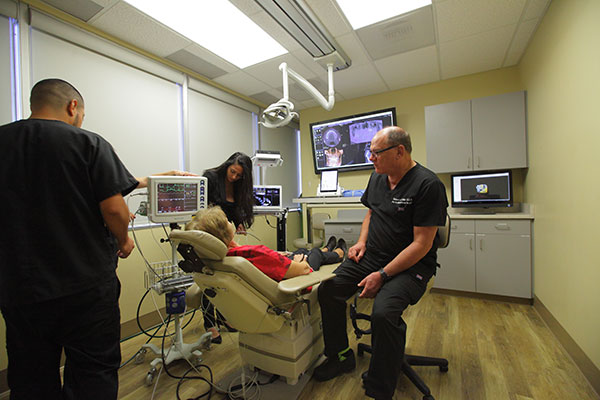FACIAL TRAUMA

When blunt force facial trauma occurs, an oral and maxillofacial surgeon is the expert in diagnosis and treatment. Ignoring lacerations, jaw injuries or fractures can lead to nerve damage, scarring, and constant pain or discomfort. Working with our team of surgeons at Woodland Hills Oral & Maxillofacial Surgery, we can ensure that treatment is handled correctly. Dr. Robert G. Hale and Dr. James P. Jensvold will evaluate and gauge the trauma through examination both visually and with the use of advanced imaging technology to create 3D digital x-rays of your mouth, followed by the creation of a treatment plan to restore your oral health. Oral surgeons take the time to consider every aspect, the physical trauma, the aesthetic trauma, and the long-term trajectory.
Facial injury includes:
- Lacerations: Injury, including gashing or piercing of the soft tissue both inside and outside of the oral cavity. There are steps that can be taken to reduce scar tissue and mitigate damage to nerves. Additionally, we will want to inspect and treat injuries to salivary glands, and salivary ducts.
- Fractures: Patients are aware when a significant break or fracture to a bone occurs, but there can also be small or hairline fractures that occur. Examination of all bone tissue, including the jaw, eye socket, cheekbone and nose is important. Once the location of the fracture is discovered, our surgeon can determine the severity of the fracture and apply treatment accordingly. There are rigid fixation procedures to assist in the correct healing of bone tissue.
- Avulsed Teeth: Teeth that have been knocked out can be restored. Depending on the situation and the speediness of response, there is the possibility of placing the natural tooth. Additionally, there are multiple options available to restore a missing tooth, including the placement of a dental implant.
- Jaw Alignment: A jaw that has been knocked out of alignment can be a source of multiple problems. Known as TMJ dysfunction, a jaw that has been knocked out of alignment can result in popping sensation, tired feeling, the inability to fully open or close the jaw joint, jaw pain, facial pain and even migraines. In some situations orthognathic surgery may be necessary to straighten the jaw, and the patient will then need an orthodontic appliance to complete the restoration.
MAXILLOFACIAL TRAUMA
Trauma can result from a variety of forms of injury. Some of the most common causes including motorized and nonmotorized vehicle accidents fall on playground equipment, sports-related injuries, interpersonal acts of violence, and work-related injuries. The level and type of facial injuries can significantly range from mild to severe. When an injury occurs, it is best to be seen and not assume that you can heal on your own. Incorrect healing can lead to more damage and severity.
Seeking proper treatment following a facial injury can make a significant difference in the long-term health of your mouth. Our team at Woodland Hills Oral & Maxillofacial Surgery is well versed in the emergency care, immediate acute treatment, additional long-term reconstruction, and the rehabilitation of the patient.
We invite you to contact our office for more information. (818) 999-0900
